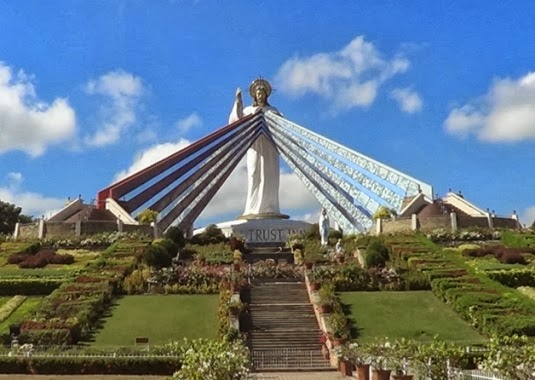Rudy, who left a comment on the video I shot says it all, “Spain in the Philippines.”
Of course, those of us who live here know he isn’t referring to the structure itself. There is no Spanish influence anywhere on it. Rudy was referring to the religious and perhaps spiritual fervor that is the influence of more than 300 years of colonial rule that has resulted in the creation of shrines like this one.
Tucked away in the quiet hills of barangays PSB and Ulaliman in El Salvador Misamis Oriental is the Divine Mercy Shrine. Popular among both tourists and pilgrims, you would not imagine that its origins are fraught with uncertainty.
As the story goes, a local charismatic group first began receiving visions in the year 2000. They were told to build a church on top of a hill overlooking the sea. Initially beset with fears, doubts and financial uncertainty, the group did not take immediate steps in answer to the visions.
When they did decide to take action, the search for land on which to start building was long and arduous. Among the places they originally visited were Surigao, Camiguin and Davao. It was only in El Salvador however that the group received signs that they interpreted to mean that they had found the location.
With only 2,000 pesos in funds, work began on the shrine in 2003. Today the shrine is within the Divine Mercy Hills which spans 9.8 hectares. At its heart is a 50 foot statue of Jesus overlooking Macajalar Bay. It is currently the biggest statue in the world for the Divine Mercy.
The blood and water streaming from the heart of Jesus are made of glass and tiles and encase stairs leading to a chamber of adoration. At the base of the statue are reconciliation rooms.
The statue alone attracts visitors in droves. Numerous testimonials, healings, conversions and answered prayers have since been reported.

Once completed, the ongoing development project will also feature a church, retreat facilities and places for reflection. Construction is now largely funded by donations. It is currently jointly managed by the Divine Mercy Foundation of Mindanao, Inc., The Congregation of the Marians of the Immaculate Conception of the Most Blessed Virgin Mary, Inc. and the Archdiocese of Cagayan de Oro.
To get to the shrine, you can ride a public jeepney in the Bulua terminal in Cagayan de Oro City. The trip will take no more than 30 minutes. At PSB-Ulaliman you can ride up to the entrance of the shrine on a motorcycle for hire. Another option is to take a 15 minute walk up.
To enter the shrine, visitors are required to wear proper clothing. Shorts and sleeveless shirts are not permitted. Long skirts and pants are provided at the entrance.
For more information on the shrine, visit www.divinemercyhills.com.
Recent Comments